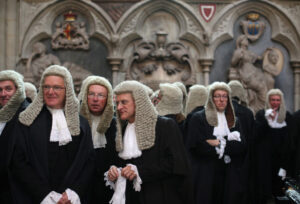“It was like staring at a Magic Eye picture,” Ravi Jayaram, one of the medics who first raised concerns about Lucy Letby, told the New Yorker. “At first, it’s just a load of dots… But you stare at them, and all of a sudden the picture appears.” For Jayaram, what was once seen was never unseen: the killer nurse, the “angel of death”. In 2023, Letby was found guilty of murdering seven babies on the neonatal unit where she worked and attempting to murder six more; at a retrial this month, she was convicted on a seventh count of attempted murder.
For others — including me — the picture can flicker in and out. The Letby case is compelling because it invites interpretation. In a media where true crime reigns, the detailed session-by-session examination of evidence allowed anyone following to play not just jury but detective, weighing the subtleties of an autopsy or the reliability of a witness. This should, in theory, generate trust in the process; instead, it generates as many different processes as there are followers of the case, a million courtrooms in a million different heads all weighting the evidence in their way — and feeling convinced of their own conclusions.
From a certain distance, her guilt looks certain: the chart presented by the prosecution showing she was on the ward for all the suspicious deaths, the scrawled notes-to-self included the phrase “I AM EVIL I DID THIS”, the handover sheets she hoarded at home, the seemingly compulsive googling of the bereaved families months or years after their babies’ deaths.
Take a step back, and it threatens to collapse into dots. It’s this that feeds the population of Letby “truthers” who are gradually gathering strength. What if the chart is a case of “Texas sharpshooter fallacy”, when you draw a target to match a random selection of data? After all, babies on neonatal wards are by-definition fragile: sometimes they die, and they will die on someone’s shift, and chance might happen to put one person on all those shifts. Initially, the deaths Letby was convicted of were seen as unexplained, rather than violent. Then, once her colleagues had become suspicious, deaths when Letby was present became suspicious by definition.
The notes might not be evidence of a guilty conscience, but of a young woman under terrible pressure from false accusations sliding into a breakdown. The googling, a sign of her grief for the babies she couldn’t save. Of the hoarded documents, the defence pointed out that fewer than 10% of the papers found at her home referred to babies on the indictment, making them unlikely to be “trophies” — however strange it was that she had kept them at all.
The case against Letby was circumstantial and rested on four things: statistics, eyewitness testimony, forensics and the confession in her notes. These also happen to be among the forms of evidence most implicated in miscarriages of justice. Statistics can easily be misrepresented, as in the case of Sally Clark, wrongly convicted of killing her two babies after the paediatrician Professor Sir Roy Meadows gave expert evidence that failed to account for the possibility of a common congenital defect.
Eyewitness recall is compelling to juries, but vulnerable to human error. When Letby’s colleagues remembered her eagerness to be present during medical crises, or their own discomfort at her reluctance to take time off — was that the thought they had at the time, or a thought they had later, overlaid on the original impression? Confessions, similarly, feel decisive, but people can accuse themselves for many reasons unrelated to the facts of the case: from a desire for attention, from a need to feel important or because they are browbeaten into it.
Forensic evidence, though it has the surety of flesh, is interpretative. Letby’s defence did not introduce their own expert witnesses to challenge the prosecution’s but since the trial, others have raised doubts about the theory that Letby attacked babies using deliberate air embolisms and insulin poisoning, including in this week’s Private Eye by the medical columnist MD. (And if we’re talking about unlikely coincidences, Private Eye and Nadine Dorries coming to similar conclusions certainly counts.)
The Countess of Cheshire Hospital, where Letby worked, was overstretched and sometimes unsanitary. Her removal from the ward coincided with a collapse in mortality, but it also coincided with the unit being downgraded so it no longer treated babies in need of intensive care, so in reality this signifies almost nothing. (It’s worth noting, though, that even if the embolisms are discounted and the insulin poisoning deemed tendentious, there is still evidence of severe trauma and overfeeding in some of the babies.)
For those querying Letby’s guilt, the implication is that she has been made the scapegoat for systemic failures. Or as Nadine Dorries asked in the Daily Mail: “Has the British justice system thrown a young woman into jail for life in order to save the tarnished reputation of the National Health Service?” The lengthy New Yorker piece (still not available in the UK because of reporting restrictions) suggested that Letby’s defence was compromised by an unwillingness to criticise the “national religion” of the NHS.
For the truthers, this has a satisfying flavour of cover-up — and would make Letby the main character in a Seventies-style conspiracy thriller, and them the brave truth tellers shaking down the system. Then again, her guilt also fits a narrative of institutional culpability. NHS managers ignored the warnings of their staff and even forced doctors to apologise to Letby for raising their concerns. Depending on how you fix your focus, the dots cohere and dissolve into different patterns.
Letby doesn’t quite fit any preconceived templates. Is she a poster girl for “privilege”? Novelist Joanne Harris tweeted that “The Letby case should teach us this: Too many people think ‘innocence’ looks white, middle-class, traditional, vulnerable, tearful. People who present this way are often unquestioningly believed and supported.” One weird response to this posture is that you can find the Letby-sympathetic dismissing the idea that she’s in anyway conventionally attractive (“she’s average at best” said one).
Letby wasn’t unquestioningly believed, clearly: her colleagues eventually thought the most unthinkable thing about her, and pursued their fears all the way to prosecution. Nor, however, does she match the pattern of the vulnerable young woman bullied by senior men that she would need to be for the more lurid truther versions of a plot against her to hold up: she stuck up for herself and won the backing of management.
What’s missing from the Letby case — and what the truthers want — is, crassly, a good story. We don’t know why she did it. Establishing motive is useful but not necessary for proving guilt, and the prosecution only hinted at possible explanations. Maybe she loved the drama of a death. Maybe she was seeking the attention of a married doctor she was said to be flirting with. Maybe she had munchausen’s by proxy. But even the police who led the investigation confess themselves baffled at her reasons.
All that’s left is the oddness of a killer who put “x” and “lol” in her texts, and drank white wine on girls’ nights out, and supposedly recorded her kills in a twee diary with a picture of a knitted teddy on the cover. One of her friends called her “hun” in a consoling text message — “Oh hun, you need a break” — and that’s what Letby seems to be: a hun. A bit basic. This is not how serial killers are supposed to be in the popular imagination. They are meant to have either the terrifying self-control of Hannibal Lector, or the chaotic impulsiveness of Leatherface in Texas Chainsaw Massacre. They are meant to get something from their violence.
Justice is not only about the facts. It is also about turning those facts into an arc that makes sense of the senseless. This is not extraneous to its core function, but fundamental to the way it allows society to move on from shocking acts of brutality. We find the “why”. We understand. It would be nice if this helped to prevent crimes in the future, but that probably isn’t the main reason we look for it: the main reason is that it lets us stop thinking about the terrible thing that has happened.
In the Letby case, the first question has always been whether something terrible did in fact happen. Were the deaths murders, or tragic misfortune? Murders, or collective incompetence? Without a narrative to anchor the idea of her guilt, there will always be just enough doubt to sustain these questions. Miscarriages of justice happen, more often than is pleasant to think. It is not ludicrous, given the nature of the evidence, to consider the possibility that this may be one of them.
Having absorbed as much of the evidence as I can bear to, I’m not one of them. The association between her presence and unexpected harm coming to babies seems too strong to be discounted, and alternative explanations such as ward-wide infections unproven. The picture of her guilt holds. But the bits that don’t fit still nag at my focus. Even after Letby’s diary was opened up to the court, she kept her secrets. As long as she remains impossible to understand, there will be an urge to change her story into something comprehensible.
Disclaimer
Some of the posts we share are controversial and we do not necessarily agree with them in the whole extend. Sometimes we agree with the content or part of it but we do not agree with the narration or language. Nevertheless we find them somehow interesting, valuable and/or informative or we share them, because we strongly believe in freedom of speech, free press and journalism. We strongly encourage you to have a critical approach to all the content, do your own research and analysis to build your own opinion.
We would be glad to have your feedback.
Source: UnHerd Read the original article here: https://unherd.com/



